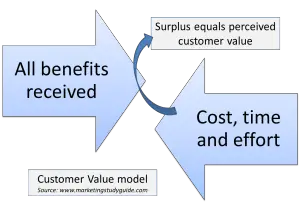Contents
What is customer value?
Customer value is a fundamental concept in the study of marketing and is usually covered in the opening chapter of a marketing textbook.
Virtually all organizations strive to deliver good overall value for both their current and potential customers value. Without providing true customer value firms will be unable to attract and retain customers. And without customers there is no functioning business in the long-term. Customers need to perceive that value exists for them – that is, they will receive more benefits than the costs they incur.
Therefore, in simple terms, customer value is when a customer perceives that the range of benefits they receive from a transaction exceeds the cost and effort undertaken to participate in that transaction. In other words, did they get a good deal and did they benefit overall from the purchase?
Customer value can be simplified into this basic formula:
customer value = all benefits received less purchase costs and time and effort
Understanding customer value
When considering customer value, it is important to understand that it is much more than simply a price/quantity view. That is, value is simply is not necessarily more getting more for your dollar.

(click to enlarge)
In lectures, when teaching this concept, I use the example of two bottles of Coca-Cola; one being a large family size and the other being an individual serving size. In supermarkets, in particular, the family size bottle sits on the shelves at room temperature, whereas the smaller size is in a refrigerator near the checkout. In many supermarkets, the smaller bottle is equal in price and sometimes greater in price than the larger bottle.
If we take the view that value is simply how much I get for what I pay, this situation makes no sense at all. It only makes sense when you think about the range of benefits that the consumer will receive from a particular purchase.
In this case, the benefits received from the smaller bottle purchase are:
- convenience, easy to carry, easier to fit in a bag,
- less socially conspicuous,
- less wastage, and
- more refreshing.
Therefore, because the smaller product, in many ways provides a greater range of benefits for an individual, consumers will be willing to purchase such an item, even though on a straight value for money (on a quantity basis) it is not as attractive as the larger family size bottle.
The family size bottle, sitting at room temperature however, is attractive to the household buyer, who has no need for immediate consumption of the beverage. Instead, they are seeking the benefit of having a suitable beverage available at home when required for the family, or perhaps when catering for a party or a family function.
You will note that in these situations the needs of these consumers differ and, as a result, are seeking different benefits – and will see different value in the two product offerings. So the key question, when considering customer value, is: “Which product offering better suits my needs?”
Further in my lectures, I then highlight that private-label and generic brands of cola are often also available in the supermarket at a lesser price same in the refrigerator section. However the well-known brands will outsell the generic ones. This situation again highlights another benefit being received by the consumer. In this case the consumer is selecting a product with strong brand equity, which may mean that they are seeking the benefit of social status and/or confidence in knowing that they have tried and already like the taste of that brand.
(More costs are discussed in the list of benefits and costs.)
Types of costs?
The second part of the customer value equation is the cost and effort involved in acquiring the product. In most cases the most significant costs considered by the consumer will be the actual price they pay for the item.
However, there are other costs that need to be considered. The time taken to purchase is another key consideration factor. For example, a consumer is willing to pay more for a cola drink at a convenience store, as opposed to going to the supermarket. This is because it is much faster for them to access and purchase via that particular type of retailer. Therefore, the amount of time involved in the purchase transaction will be considered by some consumers.
In recent years, we have seen banks and other financial institutions looking to simplify and shorten their application forms for loans and credit cards. A consumer that needs to provide a lot of detail in an application form and then provide lots of supporting documentation to a financial situation will see the whole process as requiring considerable effort. That’s why in services marketing we tend to consider the process as one of the 7P’s. Therefore another consideration of costs are much effort is involved in the overall process. (More costs are discussed in the list of benefits and costs.)
Related Topics
What is the difference between customer satisfaction and value?
